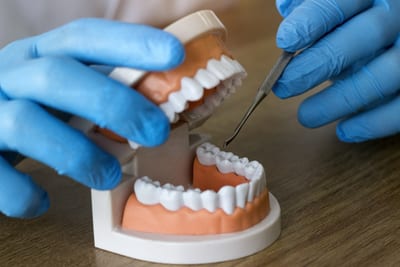
Dental crowns (sometimes referred to as caps) are recommended for teeth that are broken down, cracked, or structurally compromised due to trauma, bruxism (tooth grinding) or recent endodontic (root canal) treatment.
A crown is a fixed dental prosthesis that is permanently cemented to the tooth. It improves the structural integrity of the tooth and can improve the appearance and alignment of the occlusion (bite). A set of new crowns can rejuvenate the overall appearance of a smile.
There are three basic categories of crown:
- metal
- porcelain fused to metal (PFM)
- all ceramic.
Metal crowns
These crowns, which are often gold alloy, have been around since the early 1900s and require very minimal tooth preparation as the metal is still strong is thin sections. Metal crowns designed and constructed well are very durable and resistant to fracture.

Porcelain-fused-to-metal (PFM) crowns

PFM crowns were introduced in the 1970s and appear much more tooth-like than metal crowns due the overlying porcelain. The metal core provides strength and durability. It is common to have a thin metal margin visible around the neck of the crown on the tongue side of the crown as this preserves more tooth structure.
All-ceramic crowns
Ceramic crowns should be highly polished to avoid excessive wear of the opposing teeth.
Newer, all-ceramic crowns are now available which do not contain any metal. They are made of high-strength reinforced ceramic materials (lithium disilicate or zirconia) which are 5 to 9 times stronger than the conventional porcelain. This material replaces the metal core used in PFM technology.
All-ceramic crowns can be fabricated in a single layer (monolithic) or layered with conventional porcelain to give a very natural, aesthetically pleasing appearance. All-ceramic crowns achieve the closest match to natural, healthy teeth.
Other
In addition to the above types of crown, a partial-coverage crown can be provided if there is enough tooth structure remaining. A partial crown is more conservative, in that it preserves valuable tooth structure. Your prosthodontist can advise whether such a solution is appropriate for your circumstances.
Prosthodontists take a holistic approach and assess your entire chewing system – including your jaw muscles and joints, bite, diet, tooth wear, existing root canals and fillings – and will recommend the most suitable material and type of crown design appropriate for you.
Teeth need to be assessed and prepared for crowns before an impression can be taken. A conventional or digital impression of your teeth is then taken and the crown is constructed outside the mouth. A temporary crown may be placed while the permanent crown is being constructed.
To minimise the risk of caries (decay) around a newly inserted crown, we recommend regular checkups, cleaning and the use of remineralisation toothpastes. An occlusal splint (mouthguard) may also be recommended to protect the new crown from bruxing (grinding) forces.
